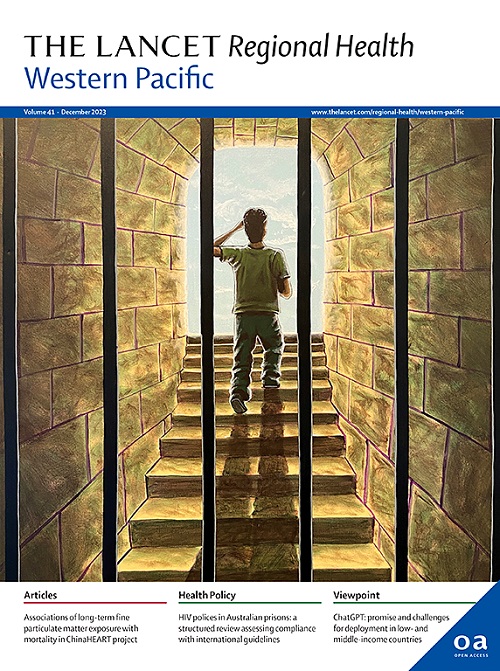Associations of reallocating sedentary leisure-time to alternative discretionary movement behaviours with incident cardiometabolic diseases in 0.5 million Chinese adults
IF 7.6
1区 医学
Q1 HEALTH CARE SCIENCES & SERVICES
引用次数: 0
Abstract
Background
In Chinese adults, there is a considerable burden of sedentary behaviour. This study aimed to estimate the implications of reallocating sedentary leisure-time to non-sedentary behaviours for incident cardiometabolic diseases.
Methods
A prospective cohort study of 462,370 Chinese adults (mean age 51 years; 59% female) who were free from diabetes and cardiovascular diseases at baseline. Isotemporal substitution Cox regression models were used to estimate the associations of reallocating self-reported sedentary leisure-time to the same amount of sleep, housework, Taichi, or conventional exercise (e.g., walking, jogging, ball games, swimming) with the risk of incident diabetes, stroke, and myocardial infarction (MI). The results are reported as adjusted hazard ratios and 95% confidence intervals per 30 min/day time exchanges. Potential impact fractions were calculated to estimate the proportional reductions in incident disease cases associated with time substitutions, assuming causality.
Findings
During >5.25 million person-years of follow-up, 19,738 incident diabetes, 51,460 stroke, and 6767 MI cases were accrued. Lower disease risks were found for replacement of sedentary leisure-time by sleep (diabetes: 0.97 [0.95–0.99], stroke: 0.98 [0.97–0.99], MI: 0.97 [0.94–0.99]; in participants who slept <7 h/day), housework (diabetes: 0.97 [0.97–0.98], stroke: 0.99 [0.98–0.99], MI: 0.97 [0.95–0.98]), Taichi (diabetes: 0.97 [0.95–0.99], stroke: 0.98 [0.97–0.99], MI: 0.95 [0.92–0.98]), or conventional exercise (diabetes: 0.97 [0.95–0.99], stroke: 0.97 [0.95–0.98], MI: 0.92 [0.88–0.96]). Potential impact fractions ranged from an estimated 3.5% (95% confidence interval: 3.1–3.9%) fewer cases of incident stroke when replacing sedentary leisure-time with housework, to an estimated 9.6% (5.9–13.3%) fewer cases of incident MI when reallocating sedentary leisure-time to conventional exercise.
Interpretation
Replacing sedentary leisure-time with behaviours such as housework, Taichi, sleep (in short sleepers) and conventional exercise is associated with lower risks of common cardiometabolic diseases in Chinese adults. Prevention strategies should be developed to promote movement behaviours and optimal levels of sleep at the expense of sedentary leisure-time.
Funding
This analysis was supported by a Health and Medical Research Fund (HMRF) Research Fellowship (grant no: 06200087).
在50万中国成年人中,重新分配久坐休闲时间与选择性自由运动行为与心血管代谢疾病的关系
在中国成年人中,久坐行为是一个相当大的负担。本研究旨在评估将久坐休闲时间重新分配给非久坐行为对突发心脏代谢疾病的影响。方法对462370名中国成年人(平均年龄51岁;(59%为女性),基线时无糖尿病和心血管疾病。使用等时间替代Cox回归模型来估计将自我报告的久坐休闲时间重新分配到相同数量的睡眠、家务、太极或传统运动(如散步、慢跑、球类运动、游泳)与发生糖尿病、中风和心肌梗死(MI)的风险之间的关系。结果以调整后的风险比和每30分钟/天时间交换的95%置信区间报告。假设因果关系,计算潜在影响分数,以估计与时间替代相关的发病率的比例减少。结果:在525万人-年的随访中,累计发生了19738例糖尿病、51460例中风和6767例心肌梗死。以睡眠代替久坐的休闲时间,患病风险较低(糖尿病:0.97[0.95-0.99],中风:0.98[0.97 - 0.99],心肌梗死:0.97 [0.94-0.99];(每天睡7小时),家务(糖尿病:0.97[0.97 - 0.98],中风:0.99[0.98 - 0.99],心肌梗死:0.97[0.95 - 0.98]),太极(糖尿病:0.97[0.95 - 0.99],中风:0.98[0.97 - 0.99],心肌梗死:0.95[0.92 - 0.98]),或常规运动(糖尿病:0.97[0.95 - 0.99],中风:0.97[0.95 - 0.98],心肌梗死:0.92[0.88-0.96])。当用家务代替久坐的休闲时间时,卒中发生率减少3.5%(95%可信区间:3.1-3.9%),当将久坐的休闲时间重新分配给传统运动时,心肌梗死发生率减少9.6%(5.9-13.3%)。在中国成年人中,用家务、太极拳、睡眠(短睡眠者)和常规运动等行为取代久坐的休闲时间,与降低常见心脏代谢疾病的风险相关。应该制定预防策略,以减少久坐的休闲时间为代价,促进运动行为和最佳睡眠水平。本分析由卫生与医学研究基金(HMRF)研究奖学金(资助号:06200087)支持。
本文章由计算机程序翻译,如有差异,请以英文原文为准。
求助全文
约1分钟内获得全文
求助全文
来源期刊

The Lancet Regional Health: Western Pacific
Medicine-Pediatrics, Perinatology and Child Health
CiteScore
8.80
自引率
2.80%
发文量
305
审稿时长
11 weeks
期刊介绍:
The Lancet Regional Health – Western Pacific, a gold open access journal, is an integral part of The Lancet's global initiative advocating for healthcare quality and access worldwide. It aims to advance clinical practice and health policy in the Western Pacific region, contributing to enhanced health outcomes. The journal publishes high-quality original research shedding light on clinical practice and health policy in the region. It also includes reviews, commentaries, and opinion pieces covering diverse regional health topics, such as infectious diseases, non-communicable diseases, child and adolescent health, maternal and reproductive health, aging health, mental health, the health workforce and systems, and health policy.
 求助内容:
求助内容: 应助结果提醒方式:
应助结果提醒方式:


